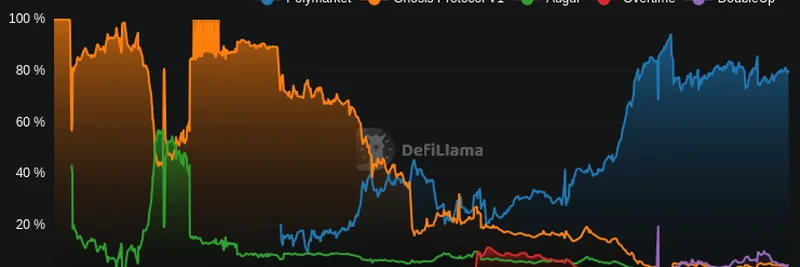In the fast-paced world of crypto, where projects can skyrocket or crash overnight, a recent thread from @0xngmi— the mind behind the transparent DeFi dashboard at DefiLlama—sheds light on the evolution of prediction markets. These are decentralized platforms where folks bet on real-world events, like election outcomes or sports results, using crypto assets. The key metric here? TVL, or Total Value Locked, which basically measures how much money is stashed in these protocols.
The thread kicks off with a striking chart showing the historical dominance of various prediction markets based on their TVL share.
Looking at the graph, you can see how things have shifted over the years. Back in 2021, Gnosis Protocol V1 held a strong position, but Augur quickly took the lead for a bit. Fast forward, and Polymarket has surged ahead, especially in 2024 and 2025, leaving others like Overtime and DoubleUp in the dust. The craziest part, as @0xngmi points out in his original tweet, is that Augur was once number one. If they'd stuck with it, they might have snagged Polymarket's whopping $9 billion valuation today.
But they didn't. They gave up. And that leads to a bigger thesis @0xngmi drops in a follow-up: early liquidity through tokens has been a disaster for many crypto projects. Take Augur—its founder got rich off the token launch, cashed out, and the project fizzled to zero. On the flip side, Polymarket skipped the token route entirely. All the value stayed in the company, forcing the team to grind it out, resulting in that massive 9-figure outcome. Recent news backs this up, with reports of ICE (the NYSE owner) pouring up to $2 billion into Polymarket at an $8-10 billion valuation, signaling huge mainstream interest.
This story hits close to home for meme token enthusiasts. In the meme coin space, we've seen countless projects launch with instant liquidity pools on platforms like Solana or Ethereum, leading to quick pumps. Founders often rug pull or abandon ship after getting their bag, leaving holders high and dry. It's a classic pump-and-dump scenario. But imagine if more meme token teams adopted Polymarket's approach: focus on building real utility, community engagement, and long-term value without the temptation of early exits. Could we see meme tokens evolve into sustainable ecosystems?
Of course, prediction markets aren't exactly meme tokens, but the parallels in blockchain innovation are clear. Projects like Augur were pioneers in decentralized oracles and event resolution, but being too early or mismanaging incentives killed their momentum. For blockchain practitioners diving into memes, this is a reminder to prioritize grit over quick gains. As crypto matures, the winners might just be those who play the long game.
If you're tracking DeFi trends, head over to DefiLlama for the latest TVL data on these markets. And who knows—maybe the next big meme token will draw from these lessons to dominate its niche.



